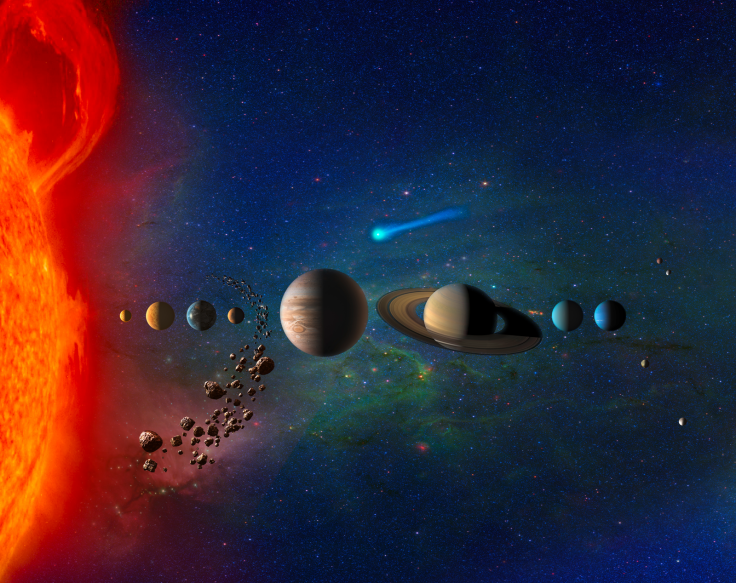WATCH: NASA Releases Visualizations Of Magnetic Fields Around Different Solar System Planets

Space was considered empty and motionless until very recently. Though most of the space is empty, scientists have, over time, discovered several interactions and forces present there. Most objects release energy into space and there is a flurry of magnetic and gravitational activity that keeps the precarious cosmic balance in check.
The magnetism of space is a very attractive area of study for scientists. Since the discovery of Magnetospheres — the magnetic fields around most planets — scientists have looked to understand this mysterious magnetic force around certain objects in space.
The atmosphere was credited with protecting earth from the harmful radiations of the dun. But the atmosphere works in tandem with magnetospheres to help “deflect high-energy, charged particles called cosmic rays that are spewed out by the Sun or come from interstellar space,” NASA said in a press release.
But magnetospheres are elusive. Not all planets have them. Scientists have not been able to detect one around Venus and Mars. NASA detected magnetospheres around other planets and one moon and all of them turned out to be different from each other.
According to the press release, “NASA has launched a fleet of missions to study the planets in our solar system — many of which have sent back crucial information about magnetospheres. The twin Voyagers measured magnetic fields as they traveled out to the far reaches of the solar system, and discovered Uranus and Neptune’s magnetospheres. Other planetary missions including Galileo, Cassini and Juno, and a number of spacecraft that orbit Earth, provide observations to create a comprehensive understanding of how planets form magnetospheres, as well as how they continue to interact with the dynamic space environment around them.”
Now, NASA has released comprehensive visualizations of Earth's magnetosphere near the time of the Equinox along with models for Jupiter, Uranus, Saturn, and Neptune.
Earth’s magnetosphere stems from the molten metal at the core. Its constant movement causes an invisible ‘force field’ around the earth. The shape of this field resembles an ‘ice cream cone’ with a rounded front and a long, trailing tail that faces away from the sun. According to the release, the magnetosphere is shaped in that particular way because of the near-constant flow of solar wind and magnetic field from the Sun-facing side.”
Along with Earth’s magnetosphere, NASA also released a pattern for other planets in our solar system. They deflect charged particles away from the planet and also trap energetic particles in radiation belts. They are also responsible for Auroras that happens when these energetic particles rain down into the atmosphere, usually not far from the magnetic poles.
Jupiter has the second strongest and biggest magnetic field in our solar system after the sun. “It stretches about 12 million miles from east to west, almost 15 times the width of the Sun. (Earth’s, on the other hand, could easily fit inside the Sun — except for its outstretched tail.) Jupiter does not have a molten metal core; instead, its magnetic field is created by a core of compressed liquid metallic hydrogen,” said the report.
One of Jupiter’s moons, Io, has powerful volcanic activity throws particles so high that it interacts with Jupiter’s magnetosphere. These particles create intense radiation belts and auroras around the planet in a process similar to that on earth.
Jupiter is so large that even its moons’ have a magnetosphere. Ganymede, Jupiter’s largest moon, has its own magnetic field and magnetosphere. Io does not have a magnetosphere but influences nearby fields. Ganymede, on the other hand, has a weak field that is completely engulfed by Jupiter’s enormous shell. It “scarcely ruffles the planet’s magnetic field,” the report added.
The visualizations also revealed that Saturn’s huge ring system affects the shape of its magnetosphere. Oxygen and water evaporate from the rocks and dust in these rings. The evaporations shoot particles into the space around the planet. “Some of Saturn’s moons help trap these particles, pulling them out of Saturn's magnetosphere, though those with active volcanic geysers — like Enceladus — spit out more material than they take in. NASA’s Cassini mission followed in the Voyagers’ wake, and studied Saturn’s magnetic field from orbit around the ringed planet between 2004 and 2017,” the report said.
Similarly, the visualization for Uranus’, which was discovered in 1986, was obtained from Voyager 2’s flyby data. “Uranus’ magnetic field and rotation axis are out of alignment by 59 degrees, unlike Earth’s, whose magnetic field and rotation axis is nearly aligned. On top of that, the magnetic field does not go directly through the center of the planet, so the strength of the magnetic field varies dramatically across the surface,” the report stated. This means that the part of the magnetosphere that trails behind the planet, away from the Sun —much like a hurtling comet.
Neptune was also visited by Voyager 2 in 1989. Its magnetosphere is very similar to that of Uranus, however, the offset from its rotation axis is only by 47 degrees. The field strength is irregular across the surface of the planet which means that auroras can appear all across the planet and just not close to the poles, like on Earth, Jupiter, and Saturn, the report said.
We have gathered the presence of magnetospheres outside of our solar system by observing auroras outside which indicate the presence of a magnetosphere. Brown dwarfs, which are objects bigger than planets but smaller than stars, display auroras. “As scientists learn more about the magnetospheres of planets in our solar system, it can help us one day identify magnetospheres around more distant planets as well,” the report added.
© Copyright IBTimes 2025. All rights reserved.





















